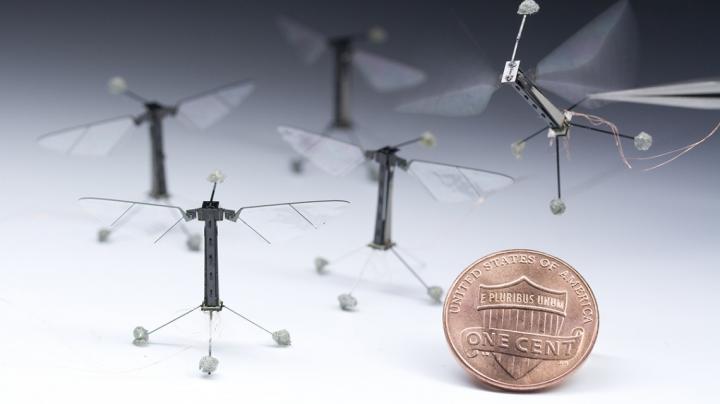
Cornell engineers are developing new programming that will make RoboBees more autonomous and adaptable to complex environments (Credit: Harvard Microrobotics Lab)
Instead of binary code, neuromorphic chips process spikes and combinations of electrical current, in a similar way to how neurons fire in the brain. ‘Event-based’ sensing and control algorithms created by the researchers would allow robot insects to react to the unpredictable scenarios that play out all the time in the real world. And as they require significantly less power than traditional processors, more computation can be packed into smaller payloads.
The Cornell team is working with the Harvard Microrobotics Laboratory, creators of the RoboBee microrobot. Currently, RoboBee remains tethered to a power source while operating, but the team behind it is looking to remove that constraint. According to the Cornell engineers, its neuromorphic algorithms could help make RoboBee more autonomous and adaptable to complex environments, with little additional weight.
"Getting hit by a wind gust or a swinging door would cause these small robots to lose control,” said Silvia Ferrari, professor of mechanical and aerospace engineering and director of Cornell’s Laboratory for Intelligent Systems and Controls
“We're developing sensors and algorithms to allow RoboBee to avoid the crash, or if crashing, survive and still fly. You can't really rely on prior modelling of the robot to do this, so we want to develop learning controllers that can adapt to any situation."
The Cornell team used a virtual simulator to test its algorithms, modelling the physical and aerodynamic forces the RoboBee experiences during each wing stroke. Aside from greater autonomy and resiliency, Ferrari said her lab plans to help outfit RoboBee with new micro devices such as a camera, expanded antennae for tactile feedback, contact sensors on the robot's feet and airflow sensors that look like tiny hairs.
"We're using RoboBee as a benchmark robot because it's so challenging, but we think other robots that are already untethered would greatly benefit from this development because they have the same issues in terms of power," said Ferrari.




Poll: Should the UK’s railways be renationalised?
I think that a network inclusive of the vehicles on it would make sense. However it remains to be seen if there is any plan for it to be for the...